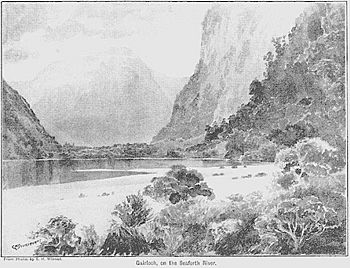Seaforth River facts for kids
Quick facts for kids Seaforth River |
|
|---|---|

Gair Loch in 1897, River Seaforth
|
|
| Country | New Zealand |
The Seaforth River is a river found in the beautiful country of New Zealand. It flows into a large inlet called Dusky Sound.
The river starts high up on the slopes of a mountain range known as the Black Giants. It begins at about 1,300 m (4,300 ft) above sea level. From there, it flows for about 20 km (12 mi) until it reaches Lake Maree. This lake is about 9 km (5.6 mi) long and sits about 41 m (135 ft) above Supper Cove in Dusky Sound. Like many places in New Zealand, the river and its lakes have names that come from Scotland.
Contents
Exploring the Seaforth River
The Seaforth River was first mapped in 1896. This was done by a man named Thomas Mackenzie. He later became the Prime Minister of New Zealand in 1912.
Mackenzie explored the river and found several waterfalls. He described them as being 10 ft (3.0 m), 25 ft (7.6 m), and 60 ft (18 m) tall. These waterfalls were located between Dusky Sound and Lake Maree. Mackenzie first named the river after himself.
However, in 1897, another explorer named E. H. Wilmot discovered something important. He found out that the river Mackenzie had named was actually the same as the Seaforth River. So, the name "Mackenzie River" was removed. The path Mackenzie followed is now part of the Dusky Track.
Nature Around the River
The area around the Seaforth River is home to many different plants and animals. When Thomas Mackenzie explored the river, he wrote about the types of trees he saw.
Plants and Trees
The main type of tree Mackenzie saw was birch. He also noted other native New Zealand trees. These included red-pine, rata, and totara.
Other plants he found were ribbon-wood, panax, mikimiki, and pepper-tree. There were also mokomoko, tutu, many ferns, and mosses.
Fish and Wildlife
In 1981, scientists did a survey of the river. They found six different types of native fish living in the Seaforth River. These fish include the longfin eel, grayling, and several types of galaxias. They also found the redfin bully.
Interestingly, moose were brought to the valley in 1910. However, it is believed that they did not survive there.
How the Lakes Were Formed
Lake Maree, which is part of the Seaforth River system, was formed in a special way. Scientists used a method called carbon dating on old tree stumps found in the lake. Carbon dating helps tell how old something is.
The dating showed that the lake was created when a very large rockfall blocked the river. This event likely happened during an earthquake in 1826. Near a place called Kintail Hut, there is another lake called Gair Loch. It was also formed by a debris dam, which means rocks and earth blocked the river. More debris fell, probably during the 2011 Christchurch earthquake.

